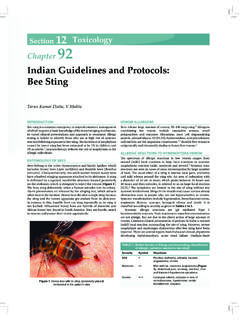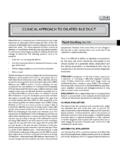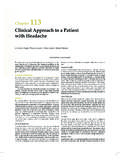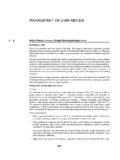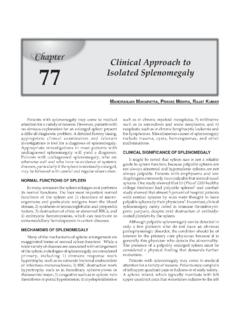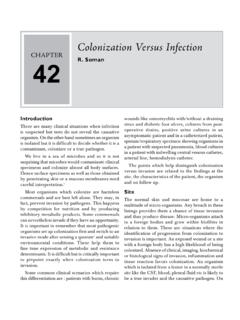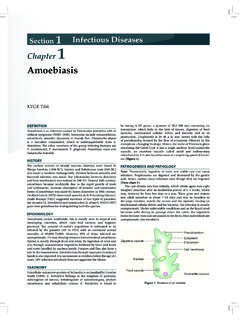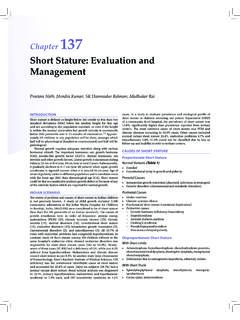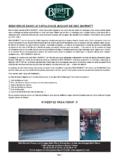Transcription of RATIONAL USE OF DIURETICS AND PATHOPHYSIOLOGY …
1 RATIONAL USE OF DIURETICS AND. PATHOPHYSIOLOGY OF EDEMA. 12 : 1 OP Kalra, Amitesh Aggarwal, Delhi Introduction The use of DIURETICS for therapeutic purposes is not new. They were used for the treatment of dropsy as early as 16th century. diuretic drugs increase urine output by the kidney by altering sodium handling. Increased sodium excretion by kidneys leads to increase in water excretion. Most DIURETICS produce diuresis by inhibiting the reabsorption of sodium at different segments of the renal tubular system. diuretic use in clinical practice spans conditions like edema, hypertension, metabolic acidosis and hyperkalemia. Patients with nephropathy or heart failure may have a 10 to 30% increase in extracellular and blood volume, even in the absence of overt edema1. Classification Multiple classes of DIURETICS are available for use including loop DIURETICS , thiazides and potassium- sparing DIURETICS . The level of GFR and need and urgency for reduction in ECF volume dictates the choice of diuretic agent.
2 Thiazide DIURETICS Thiazide DIURETICS inhibit the apical Na+-Cl- cotransport system in the distal tubule. Metabolism of thiazide DIURETICS is variable. Bendroflumethiazide and indapamide are primarily metabolized by the liver; while hydrochlorothiazide and metolazone are metabolized by the kidney. They are delivered to their luminal site of action by organic anion transporters in the straight segment of the proximal tubule, consequent of their extensive protein binding. Considerable protein binding makes role of glomerular filtration inconsequential in entry of thiazide diuretic into the urinary space. Loop DIURETICS Loop DIURETICS act by inhibiting the Na+-K+-2Cl- cotransporter in the thick ascending limb of the loop of Henle delivered to their luminal site of action by organic anion transporters. By blocking the transporter in the cortical segments, the loop DIURETICS enhance free water clearance. The bioavailability of loop DIURETICS is not affected by renal insufficiency.
3 On an average, 50% (range 10-100%) of an orally administered dose of furosemide is absorbed2. In contrast, absorption of bumetanide and torsemide, is nearly complete (80- 100%). Loop DIURETICS are primarily bound to albumin. Torsemide is approximately 80% cleared by the liver. Bumetanide is approximately 50% metabolized by the liver and its half-life does not appreciably change in kidney failure. Approximately 50% of the dose of furosemide is excreted unchanged; the remainder is conjugated to glucuronic acid in the kidney. Therefore, in patients with kidney failure, the plasma half-life of furosemide is prolonged. Potassium sparing DIURETICS There are two principal types of potassium-sparing DIURETICS , those that inhibit epithelial sodium channels (triamterene and amiloride) and those that inhibit mineralocorticoid receptors (aldosterone antagonists). For both types, the site of action is in the collecting tubule.
4 The absorption of potassium- sparing DIURETICS is quite variable. The total protein binding is low for amiloride and high for spironolactone. Amiloride and triamterene undergo significant excretion by the kidney, both by glomerular filtration and tubular secretion by the organic cation secretory pathway. Spironolactone 601. Medicine Update 2012 Vol. 22. is metabolized by the liver; its pharmacokinetic property is free water excretion leads to extracellular volume expansion not significantly affected by chronic kidney disease (CKD). and total body volume overload manifesting clinically when the GFR falls to less than 10-15 mL/min. As kidney function Loop Thiazide Potassium declines further, peripheral edema and pulmonary edema sparing appears. At a higher GFR, excess sodium and water intake Pharmacody- Increases Increases Increases could result in a similar picture if the ingested amounts namic effects excretion of Na, excretion of Na, excretion of K, Ca, Mg K, Mg, decrease Na, decrease of sodium and water exceed the available potential for excretion of Ca excretion of Ca, compensatory excretion.
5 K, Mg The interstitial inflammation of the kidney has a key role Site of action Thick ascending Distal tubule Collecting tubule limb in the pathogenesis of nephrotic edema by inducing primary sodium retention. Both decrease in sodium filtration and Transporters Na+ K+ 2Cl- co Apical Na+ Cl- co Epithelial Na+. increase in net sodium reabsorption occur due to generation affected transporter transporter channels or min- eralocorticoids of vasoconstrictive substances in the interstitium, driven by receptors the inflammatory cell infiltrate. Reduction in plasma oncotic % of filtrate 20-30% 6-11% < 5% pressure also plays a key role in the pathogenesis of edema. reabsorbed at site Thus, hypoalbuminemia effectively buffers the hemodynamic of action effects of acute increments in blood volume as the fluid Bioavailability 50-100% 40-90% 30-90% overload is sequestered into the tissues5 and is responsible (Adapted from K/DOQI clinical practice guidelines on hypertension and for the fact that while patients with acute glomerulonephritis antihypertensive agents in chronic kidney disease) Am J Kidney Dis.
6 2004 show a steep relationship between weight gain and the May; 43(5 Suppl 1):S1-290) humoral response, indicating plasma expansion, the patients PATHOPHYSIOLOGY of edema with nephrotic syndrome do not6. Low plasma colloid oncotic pressure and primary sodium retention combine to overwhelm Cardiac: Fluid retention is a consistent finding in almost all the mechanisms protecting from changes in interstitial acute and most chronic heart failure patients. It manifests as volume7-10 and drive the development of edema (Fig. 1). pulmonary and peripheral edema. The PATHOPHYSIOLOGY of edema in heart failure involves the activation and interplay of Hepatic: Patients with cirrhosis of liver share a common multiple neurohumoral and cellular systems. Pathobiologically PATHOPHYSIOLOGY of arterial underfilling secondary to decreased important alterations occur in the sympathetic nervous cardiac output and decreased systemic vascular resistance, system, the renin-angiotensin-aldosterone system (RAAS), respectively, with eventual stimulation of neurohumoral the vasopressin axis, and vasodilatory/ natriuretic pathways.
7 Axis and sodium and water retention. The resultant renal These disturbances are translated at the renal circulatory and vasoconstriction and sodium and water retention lead to ascites tubular level in such a way that avid retention of sodium and and hepatorenal syndrome in advanced cirrhosis. Two key water occurs3. The state of the arterial circulation, as governed PROTEINURIA. by cardiac output and peripheral vascular resistance, is the chief determinant of sodium and water retention in heart failure4. Tubulointerstitium Glomeruli HYPOALBUMINEMIA. In particular, either a primary decrease in cardiac output or Infiltration T cells, MФ Kf arterial vasodilatation brings about arterial underfilling, which All, NO SNGFR. activates neurohumoral reflexes that in turn incite sodium and water retention. Sympathetic nervous system activity Na reabsorption Filtered Na contributes to peripheral and renal vasoconstriction and to Secondary Primary UNa V.
8 Sodium and water retention. Activation of renal sympathetic Na retention Na retention nerves leads to angiotensin II release, stimulating the renin- Intravascular angiotensin-aldosterone system. Sympathetic stimulation volume also prompts release of arginine vasopressin, excess levels of PC PCOP. Overwhelmed mechanisms which lead to water retention and hyponatremia. Angiotensin of edema removal II acts as a potent vasoconstrictor, stimulates aldosterone release from the adrenal gland, and promotes renal tubule EDEMA. sodium reabsorption. Aldosterone increases reabsorption of sodium in the collecting duct. Fig. 1: Overview of PATHOPHYSIOLOGY of edema formation in nephrotic syndrome. (Adapted from Rodr guez-Iturbe B, Herrera- Renal: Chronic renal insufficiency (CRI) leads to alteration in Acosta J, Johnson RJ. Interstitial inflammation, sodium retention, salt and water handling by the kidney. Failure of sodium and and the pathogenesis of nephrotic edema: A unifying hypothesis.)
9 Kidney Int 2002; 62: 1379 1384.). 602. RATIONAL Use of DIURETICS and PATHOPHYSIOLOGY of Edema factors are involved in the pathogenesis of ascites formation microalbuminuria in diabetic patients with hypertension sodium and water retention, and portal hypertension. found that diuretic -based therapy was equivalent to an ACE. inhibitor-based therapy20. It is generally recommended that There is an overlap between CKD and heart failure11, patients with chronic renal disease receive a diuretic along having a complex bidirectional pathophysiologic state12 that with an ACE inhibitor or ARB as part of the strategy to reach worsens the function of both organs known as cardio renal target blood pressure16,21,22. syndrome (CRS). In Chronic CRS (Type 2), longstanding heart failure leads to progressive CKD, possibly via episodes Increased rate of fluid delivery and reabsorption per nephron of acute kidney injury (AKI). Optimal management of in the loop segment and relative preservation of the target sodium and extracellular fluid volume through low-sodium transporters is a critical factor in the retained efficacy of loop diet and DIURETICS is important in prevention of chronic DIURETICS even in advanced renal insufficiency.
10 On the other CRS. Many studies indicate that the lowest doses of loop hand, thiazide DIURETICS when used alone become relatively DIURETICS necessary to maintain hemodynamics are optimal13. ineffective in patients with a moderate to severe degree of CRI. Conversely, those patients requiring the highest doses of (creatinine clearance < 35 ml / min), although high doses of loop DIURETICS have the highest rates of CRS and mortality thiazide DIURETICS , such as metolazone, do retain some efficacy probably by further activation of neurohumoral pathways14. in even advanced CRI23. Another form of chronic CRS (Type 4) may be recognized who Loop DIURETICS have been prescribed to patients with end- have repetitive bouts of cardiac ischemia and injury reflected stage renal disease (ESRD) in an attempt to slow the rate by chest pain, electrocardiogram changes and elevations in of loss of GFR. An observational study of 125 patients with cardiac biomarkers.
